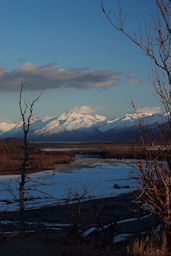 When a fly fisherman day dreams of Alaska certain images are prevalent in those thoughts.
Such things as wild rivers on the edge of the world teeming with willing salmon may be among them. Add in the Alaskan Brown Bear catching fish with ease along the shore line while a bald eagle jealously eyes the bears catch and the image starts to take shape right?
Well thatís the way it can be here in Alaska but sometimes it takes awhile to get all of the players together, including you. Even after years of honing your skills and compiling a collection of the best salmon fishing gear available there can still be some unexpected developments once you are actually here.
When a fly fisherman day dreams of Alaska certain images are prevalent in those thoughts.
Such things as wild rivers on the edge of the world teeming with willing salmon may be among them. Add in the Alaskan Brown Bear catching fish with ease along the shore line while a bald eagle jealously eyes the bears catch and the image starts to take shape right?
Well thatís the way it can be here in Alaska but sometimes it takes awhile to get all of the players together, including you. Even after years of honing your skills and compiling a collection of the best salmon fishing gear available there can still be some unexpected developments once you are actually here.
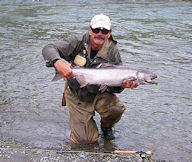 Me, I didnít come here just to fish I came here because of a job and I figured that fishing would be a great fringe benefit. You might think that if you were living in Alaska you would be able to limit out on your king salmon stamp every year, right? Itís not always an easy thing to do; you are allowed one fish per day with a season total of five king salmon. I had a few really good years when I first moved to Anchorage. Of course I traveled all over the area, From Talkeetna to Homer and over to Seward. If a road would get me there I went.
I was and still am mesmerized by the splendor that seems to be lurking just around the next turn. By the end of my first fishing season I had wet a line in most of the well known rivers and creeks accessible by the AK. road system but guesses where I did my best king salmon fishing? Now youíre probably thinking I chartered a float plane and had the pilot take me to the most rugged and remote corner of the state but what I did was far from that. Traveling to the bush requires that you have both the time and the assets to first get there and secondly, stay long enough to get your monies worth. So after weighing all of the circumstances that I had on my plate I did what many of the city bound fishermen who reside in Alaskaís largest city, (Anchorage) do.
Me, I didnít come here just to fish I came here because of a job and I figured that fishing would be a great fringe benefit. You might think that if you were living in Alaska you would be able to limit out on your king salmon stamp every year, right? Itís not always an easy thing to do; you are allowed one fish per day with a season total of five king salmon. I had a few really good years when I first moved to Anchorage. Of course I traveled all over the area, From Talkeetna to Homer and over to Seward. If a road would get me there I went.
I was and still am mesmerized by the splendor that seems to be lurking just around the next turn. By the end of my first fishing season I had wet a line in most of the well known rivers and creeks accessible by the AK. road system but guesses where I did my best king salmon fishing? Now youíre probably thinking I chartered a float plane and had the pilot take me to the most rugged and remote corner of the state but what I did was far from that. Traveling to the bush requires that you have both the time and the assets to first get there and secondly, stay long enough to get your monies worth. So after weighing all of the circumstances that I had on my plate I did what many of the city bound fishermen who reside in Alaskaís largest city, (Anchorage) do.
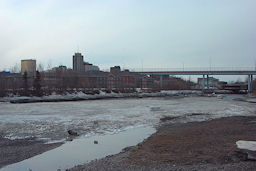 The natural course of action was to get it done close to home meaning Ďurban salmon fishingí and quite possibly urban salmon at its best.
First of all, getting used to combat fishing for kings in downtown Anchorageís Ship Creek is not for the faint of heart by any stretch of the imagination. I am a veteran of Great Lakes tributaries fishing and even that canít properly prepare you for the action at ĎShipí as itís known to Anchorians. The main differences are that the area of Ship open to salmon fishing is very close to the ocean inlet and the tides experienced there are extreme. The fact that the creek runs right into one of the busiest sea ports on the west coast and that you can see the Anchorage Hilton from the creek make it a little different than anywhere else Iíve ever fished for salmon. The crowd of hopeful king salmon fishermen & women can be intimidating but mastering the tide is the key for success there. In my first few visits I found that a personís physical height was a very big asset. Iím six foot five inches tall and quickly learned that my height enabled me to wade down the river as the tide was going out ahead of everyone else. After learning the strata of the river channel and timing the tides I was able to get to the sweet spots first and establish a beachhead of sorts. As the tide recedes, land becomes exposed with every few passing minutes. As the river level drops the current returns and the lies become visible. If a pod of fresh fish has come in on the tide the action is fast and furious to say the least. Knowing where to cast and how many split shot to apply to the leader are crucial to a quick hookup. I must add that having a good technique for handling & landing a King that can weigh up to 50 pounds is a must. I have hooked many bright chrome flanked fish that could not be handled by any means. King salmon in Alaska can grow to proportions exceeding 80 Lbs. but Ship Creeks escapement consists of hatchery reared fish and they seldom pass the 55 Lb. mark. Believe me a 55 Lb. King fresh from the salt will test your skills at handling a fish to their limits.
The natural course of action was to get it done close to home meaning Ďurban salmon fishingí and quite possibly urban salmon at its best.
First of all, getting used to combat fishing for kings in downtown Anchorageís Ship Creek is not for the faint of heart by any stretch of the imagination. I am a veteran of Great Lakes tributaries fishing and even that canít properly prepare you for the action at ĎShipí as itís known to Anchorians. The main differences are that the area of Ship open to salmon fishing is very close to the ocean inlet and the tides experienced there are extreme. The fact that the creek runs right into one of the busiest sea ports on the west coast and that you can see the Anchorage Hilton from the creek make it a little different than anywhere else Iíve ever fished for salmon. The crowd of hopeful king salmon fishermen & women can be intimidating but mastering the tide is the key for success there. In my first few visits I found that a personís physical height was a very big asset. Iím six foot five inches tall and quickly learned that my height enabled me to wade down the river as the tide was going out ahead of everyone else. After learning the strata of the river channel and timing the tides I was able to get to the sweet spots first and establish a beachhead of sorts. As the tide recedes, land becomes exposed with every few passing minutes. As the river level drops the current returns and the lies become visible. If a pod of fresh fish has come in on the tide the action is fast and furious to say the least. Knowing where to cast and how many split shot to apply to the leader are crucial to a quick hookup. I must add that having a good technique for handling & landing a King that can weigh up to 50 pounds is a must. I have hooked many bright chrome flanked fish that could not be handled by any means. King salmon in Alaska can grow to proportions exceeding 80 Lbs. but Ship Creeks escapement consists of hatchery reared fish and they seldom pass the 55 Lb. mark. Believe me a 55 Lb. King fresh from the salt will test your skills at handling a fish to their limits.
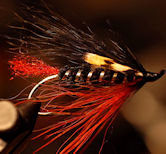 Surprisingly I found that I was sharing the beat along the creek with some of the same people every day that I was there, which was almost every day!
It may seem not to be the place where you would form alliances with other fishermen and to share patterns and techniques but it was in fact no different than fishing anywhere else. The true fly fishermen tended to gravitate toward one another and we shared the honey holes with great regard for fishing ethics and manners. Bonds were formed like I had not had with strangers in all my years of fishing so I must say the experience was both enlightening and enriching at once. In the years since my initiation at Ship, I have fished many of our rivers and creeks for king salmon but my memories of fishing right next to the salt in downtown Anchorage remain as some of my best. My most exciting king salmon fishing stories were all spawned along the beat on Ship Creek. The fish hooked there just simply go wild, I mean jumping and running with a tremendous level of strength. When I fish the rivers of the interior it always seems that I can pretty well stand my ground while fighting a king, but back on Ship I often found myself chasing one back toward the salt even on a nine weight rod equipped with a twenty five pound test leader. You see, after the fish have traversed miles and miles of fresh water rivers to reach the creeks along the Parks Highway in the Matanuska Valley where I now live they lose that bright chrome color and begin to turn sort of blush pink or magenta on their flanks and they quickly learn to avoid people and the many flies & lures that are hurled at them wherever they show themselves. So not only are they harder to catch but they are not as energetic. The meat of the fish also begins to deteriorate quickly once they are in the river systems and often they can be landed without any streamside sprinting just to keep up as they run. I constantly find myself thinking of returning to urban fishing just to recapture some of that excitement I felt when I had first came to this wonderful place. I would like to look for some of my early Alaskan fishing acquaintances that left behind years ago in that urban fishermanís paradise known simply as Ship.
Surprisingly I found that I was sharing the beat along the creek with some of the same people every day that I was there, which was almost every day!
It may seem not to be the place where you would form alliances with other fishermen and to share patterns and techniques but it was in fact no different than fishing anywhere else. The true fly fishermen tended to gravitate toward one another and we shared the honey holes with great regard for fishing ethics and manners. Bonds were formed like I had not had with strangers in all my years of fishing so I must say the experience was both enlightening and enriching at once. In the years since my initiation at Ship, I have fished many of our rivers and creeks for king salmon but my memories of fishing right next to the salt in downtown Anchorage remain as some of my best. My most exciting king salmon fishing stories were all spawned along the beat on Ship Creek. The fish hooked there just simply go wild, I mean jumping and running with a tremendous level of strength. When I fish the rivers of the interior it always seems that I can pretty well stand my ground while fighting a king, but back on Ship I often found myself chasing one back toward the salt even on a nine weight rod equipped with a twenty five pound test leader. You see, after the fish have traversed miles and miles of fresh water rivers to reach the creeks along the Parks Highway in the Matanuska Valley where I now live they lose that bright chrome color and begin to turn sort of blush pink or magenta on their flanks and they quickly learn to avoid people and the many flies & lures that are hurled at them wherever they show themselves. So not only are they harder to catch but they are not as energetic. The meat of the fish also begins to deteriorate quickly once they are in the river systems and often they can be landed without any streamside sprinting just to keep up as they run. I constantly find myself thinking of returning to urban fishing just to recapture some of that excitement I felt when I had first came to this wonderful place. I would like to look for some of my early Alaskan fishing acquaintances that left behind years ago in that urban fishermanís paradise known simply as Ship.
Ard Stetts
The Flies






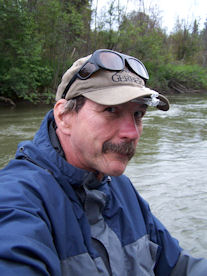
Ard Stetts was born in
north central Pennsylvania, but now resides in Alaska. He has been tying classic Salmon, Landlocked Salmon and Featherwing
Trout Streamers for 35 years and has learned from some of the best.
Also see
The Flies of Ard Stetts.